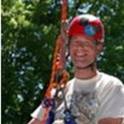Shade trees provide many benefits but can cause damage if they fail. Despite the potential for costly litigation that sometimes arises when damage occurs, there are no investigations of bending moments and stresses involved in failure of shade trees. Twenty-four shade trees of three species in the genus Acer were pulled to failure at a suburban property in Massachusetts, U.S. The maximum load and distance to failure were used to calculate maximum bending moment; stress at the point of failure was calculated from bending moment and stem cross-sectional dimensions. No trees uprooted, and failures were categorized as either stem at a lateral branch(es) or the attachment of codominant stems. Failures of codominant stems required one-half of the stress of stem failures. Similarly, failures of codominant stems occurred at only 45% of wood strength, whereas stem failures occurred at 79% of wood strength. Prediction of maximum bending moment from tree morphometric data was more reliable than prediction of maximum stress from tree morphometric data. Prediction of maximum bending moment and stress was more reliable for stem failures than codominant failures. Results are compared with similar tests on conifers. Implications of findings are discussed with respect to risk assessment of shade trees.
- Codominant stems,
- tree failure,
- tree pulling,
- trunk stress
Available at: http://works.bepress.com/brian_kane/13/
